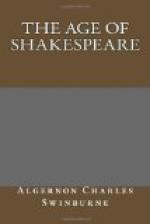The copies of two dramatic nondescripts now happily preserved and duly treasured in the library of the British Museum bear inscribed in the same old hand, at the head of the first page and again on the last page under the last line, the same contemptuous three words—“silly old story.” And I fear it can hardly be maintained that either Chapman, when writing “The Blind Beggar of Alexandria,” or Rowley, when writing “A Shoemaker, a Gentleman,” was engaged in any very rational or felicitous employment of his wayward and unregulated powers. “The Printer” of the play last named assures “the Reader” of 1638, whom he assumes to be a member of the gentle craft, that “as plays were then, some twenty years agone, it was in the fashion.” A singular fashion, the rare modern reader will probably reflect: especially when he remembers how far finer and how thoroughly charming a tribute of dramatic and poetic celebration had been paid full eighteen years earlier to the same favored craft by the sweeter and rarer genius of Dekker. This quaintly apologetic assurance of by-gone popularity in subject and in style will remind all probable readers of Heywood’s prologue to “The Royal King and Loyal Subject,” and his dedicatory address prefixed to “The Four Prentices of London.” It happily was not, however, in the printer’s power to aver that such impudently immetrical verse as Rowley at once breaks ground with was ever in fashion with any of his famous fellows. Nothing can be worse than the headlong and slipshod stumble of Dekker’s at its worst; but his were the faults of hurry and impatience and shamefully scamped work: Rowley’s, if I mistake not, is the far graver error of a preposterous theory that broken verse, rough and untunable as the shock of short chopping waves, is more dramatic and liker the natural speech of men and women than the rolling and flowing verse of Marlowe and of Shakespeare: which is as much liker life as it is nobler and more satisfying in workmanship. In reading bad verse the reader is constantly reminded that he is not reading good prose; and this is not the effect produced by true realism—the impression left by actual intercourse or faithful presentation of it.
The hagiology of this eccentric play is more like Shirley’s in “St. Patrick for Ireland” than Dekker’s and Massinger’s in “The Virgin Martyr.” Assuredly there is here nothing like the one incomparably lovely dialogue of Dorothea with her attendant angel. But there is the charm of a curious simplicity and sincerity in Rowley’s straightforward and homely dramatic handling of the supernatural element: in the miracle of St. Winifred’s well, and the conversion of Albon into St. Alban by “that seminary knight,” as the tyrant Maximinus rather comically calls him, Amphiabel Prince of Wales. The courtship of the princely Offa, while disguised as the shoemaker’s apprentice Crispinus, by the Roman Princess Laodice, daughter of Maximinus, is very lively and dramatic: the sprightliest scene, I should say, ever played out on the stage of Rowley’s fancy. On the other hand, the martyrdom of St. Winifred and St. Hugh is an abject tragic failure; an abortive attempt at cheap terror and jingling pity, followed up by doggrel farce of intolerable grossness.




